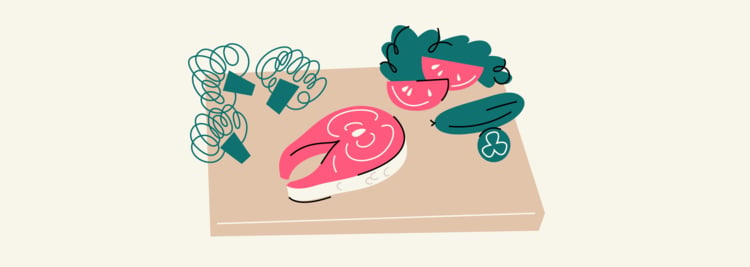Endometriosis is not a rare condition: according to statistics, 1 in 10 women have it. But it does require care, and diet can be a valuable tool for management of endometriosis. Read on to learn more about the endometriosis diet plan and what to eat and what to avoid with the condition.
-
Tracking cycle
-
Getting pregnant
-
Pregnancy
-
Help Center
-
Flo for Partners
-
Anonymous Mode
-
Flo app reviews
-
Flo Premium New
-
Secret Chats New
-
Symptom Checker New
-
Your cycle
-
Health 360°
-
Getting pregnant
-
Pregnancy
-
Being a mom
-
LGBTQ+
-
Quizzes
-
Ovulation calculator
-
hCG calculator
-
Pregnancy test calculator
-
Menstrual cycle calculator
-
Period calculator
-
Implantation calculator
-
Pregnancy weeks to months calculator
-
Pregnancy due date calculator
-
IVF and FET due date calculator
-
Due date calculator by ultrasound
-
Medical Affairs
-
Science & Research
-
Pass It On Project New
-
Privacy Portal
-
Press Center
-
Flo Accuracy
-
Careers
-
Contact Us
Endometriosis Diet: What to Eat and What to Avoid


Every piece of content at Flo Health adheres to the highest editorial standards for language, style, and medical accuracy. To learn what we do to deliver the best health and lifestyle insights to you, check out our content review principles.
Overview of endometriosis
Endometriosis is a condition in which endometrial tissue grows outside the uterus instead of inside of the uterus, most commonly on the ovaries and the peritoneal cavity but sometimes on the liver, abdominal wall, and the diaphragm. Endometriosis is present in about 6–10 percent of women in the USA. It’s usually associated with pelvic pain and infertility and may increase the risk of ovarian cancer. On average, about 30–40 percent of women with endometriosis may be subfertile.
Endo diet: what foods to choose
Following the below-mentioned diet for endometriosis may help reduce your symptoms:
Increase the consumption of omega-3 fats
These are healthy fats with anti-inflammatory effects that are present in fatty fish and various other plant and animal food sources. Omega-3 fats act as the primary ingredient of the body’s pain and inflammation relieving molecules. Since endometriosis causes inflammation and pain, increasing the consumption of omega-3 fats in your diet may help reduce these symptoms. Omega-3 fats may also reduce the risk of developing the condition.
Eat lots of vegetables, fruits, and whole grains

Whole grains, vegetables, and fruits are a rich source of fiber, minerals, and vitamins. They also provide a high dose of antioxidants that may help combat inflammation. Making these foods part of an endometriosis diet may help both reduce pain and the overall risk of developing the condition.
Try a low-FODMAP diet
This diet may help reduce symptoms associated with endometriosis. The FODMAP diet restricts foods that are fermentable, oligo-, di- and monosaccharides and polyols. The bacteria in the gut ferment FODMAPs, causing gas, which can cause discomfort and pain in people with irritable bowel syndrome (IBS). Following low-FODMAP guidelines as your endometriosis diet may help in reducing symptoms of the condition if you have endometriosis along with IBS.
Try a gluten-free diet
There is evidence that eating a diet free of gluten may benefit people with endometriosis. In clinical studies, it has been found that people who ate a gluten-free diet as part of their endometriosis diet plan had a significant reduction in their pelvic pain.
Include soy in your diet
Though according to some evidence soy may cause a negative influence on endometriosis, certain other studies indicate that it may reduce its risk or severity.
Include curcumin in your diet
Making curcumin, a compound found in turmeric, part of your endometriosis diet may reduce the severity of the condition because it suppresses the growth of the endometrial cells.
Foods to avoid with endometriosis
Avoid the following foods to reduce the symptoms of endometriosis:
Avoid artificial trans fats
Artificial trans fats, present in certain processed foods such as donuts, fries, pastries, and crackers, increase your risk of cardiovascular disease. According to some evidence, eating foods with a high amount of trans fats increases the risk of occurrence of endometriosis, so it’s best to avoid them as part of an endometriosis diet.
Reduce the consumption of red meat
Consuming more than two servings of red meat per day, particularly the processed varieties, has been found to increase the risk of endometriosis in women in certain studies. Eating another source of protein in place of red meat may help improve the inflammation that is one of the characteristics of endometriosis. While making your endometriosis diet plan, make sure to incorporate other sources of protein into your meals.
Limit alcohol and caffeine
Some research studies suggest that alcohol and caffeine may increase your risk of endometriosis. Furthermore, high caffeine intake may also increase your levels of estrogen. While the evidence isn’t conclusive, it’s preferable to reduce the intake of both alcohol and caffeine if you have endometriosis.
Limit your intake of processed foods
Processed foods contain high amounts of unhealthy sugar and fats and are low in fiber and essential nutrients. They may promote the occurrence of inflammation and pain. Omega-6 fats — present in plant oils including corn, peanut, and cottonseed oil — may increase pain, inflammation, and uterine cramping. On the contrary, omega-3 fats present in walnuts, flax, and fish may help in reducing these symptoms. Removing processed food items such as chips, pastries, candy, fried foods, and crackers from your endo diet may help minimize the pain related to endometriosis.
What else to try to manage endometriosis
Apart from an endometriosis treatment diet, the best management approach is to consult your physician and follow a specific treatment plan.
Physical therapy may help reduce pain and improve the quality of life for people with endometriosis. Doing physical exercise regularly has a protective effect against inflammatory diseases because it increases the levels of anti-inflammatory compounds in the body. Eight weeks of exercise can be very effective for reducing postural abnormalities and pain related to endometriosis.
The takeaway about endometriosis diets
Endometriosis has no cure, and medical or surgical treatments are the most beneficial and effective methods to manage the condition. But making certain dietary changes may help manage and reduce the symptoms related to endometriosis for some. A dietitian can help you find the right endometriosis diet plan. A specific plan that is tailored according to your requirements will yield the best results.
Take a quiz
Find out what you can do with our Health Assistant


Hey, I'm Anique
I started using Flo app to track my period and ovulation because we wanted to have a baby.


The Flo app helped me learn about my body and spot ovulation signs during our conception journey.


I vividly
remember the day
that we switched
Flo into
Pregnancy Mode — it was
such a special
moment.
Real stories, real results
Learn how the Flo app became an amazing cheerleader for us on our conception journey.




